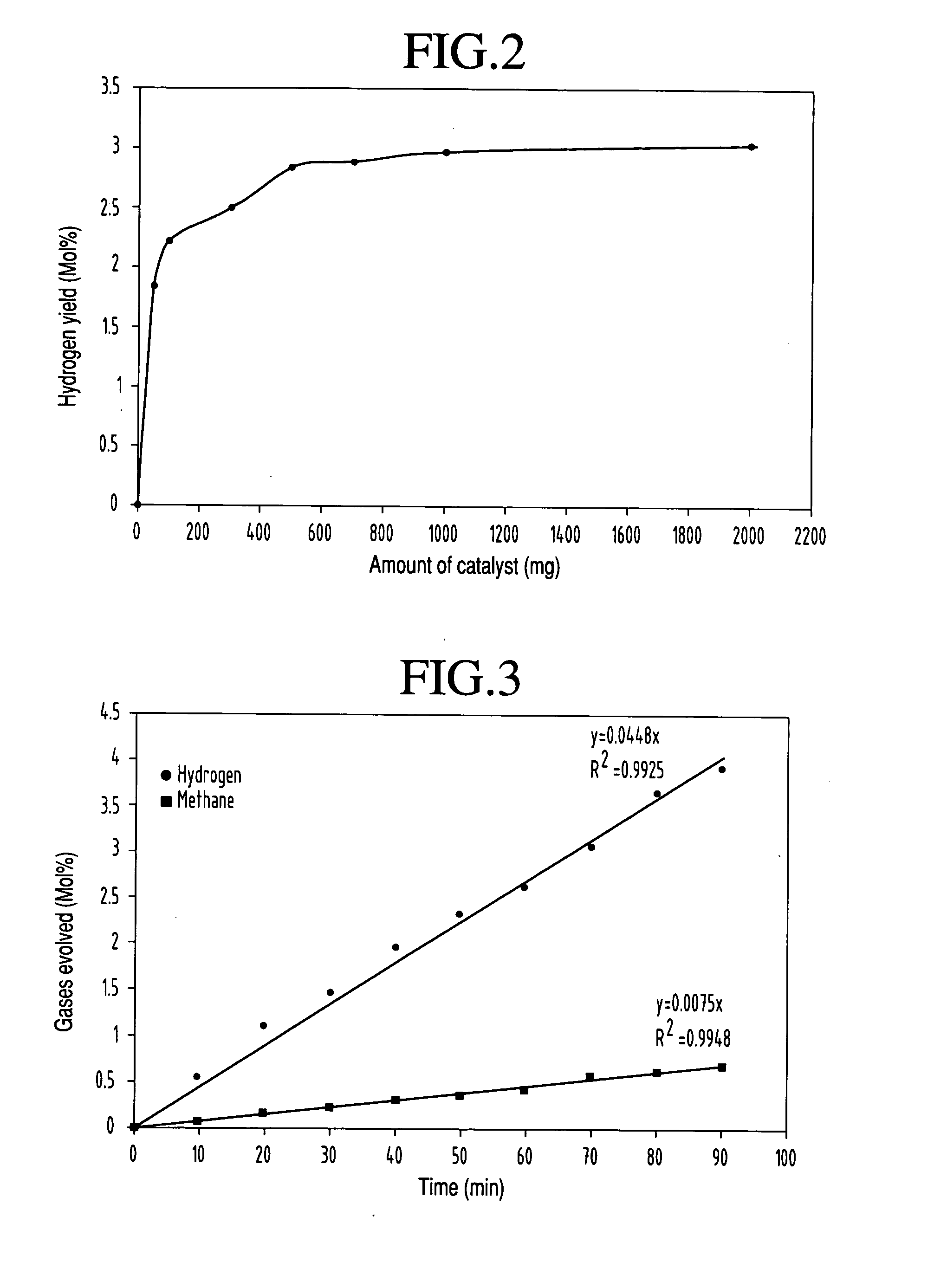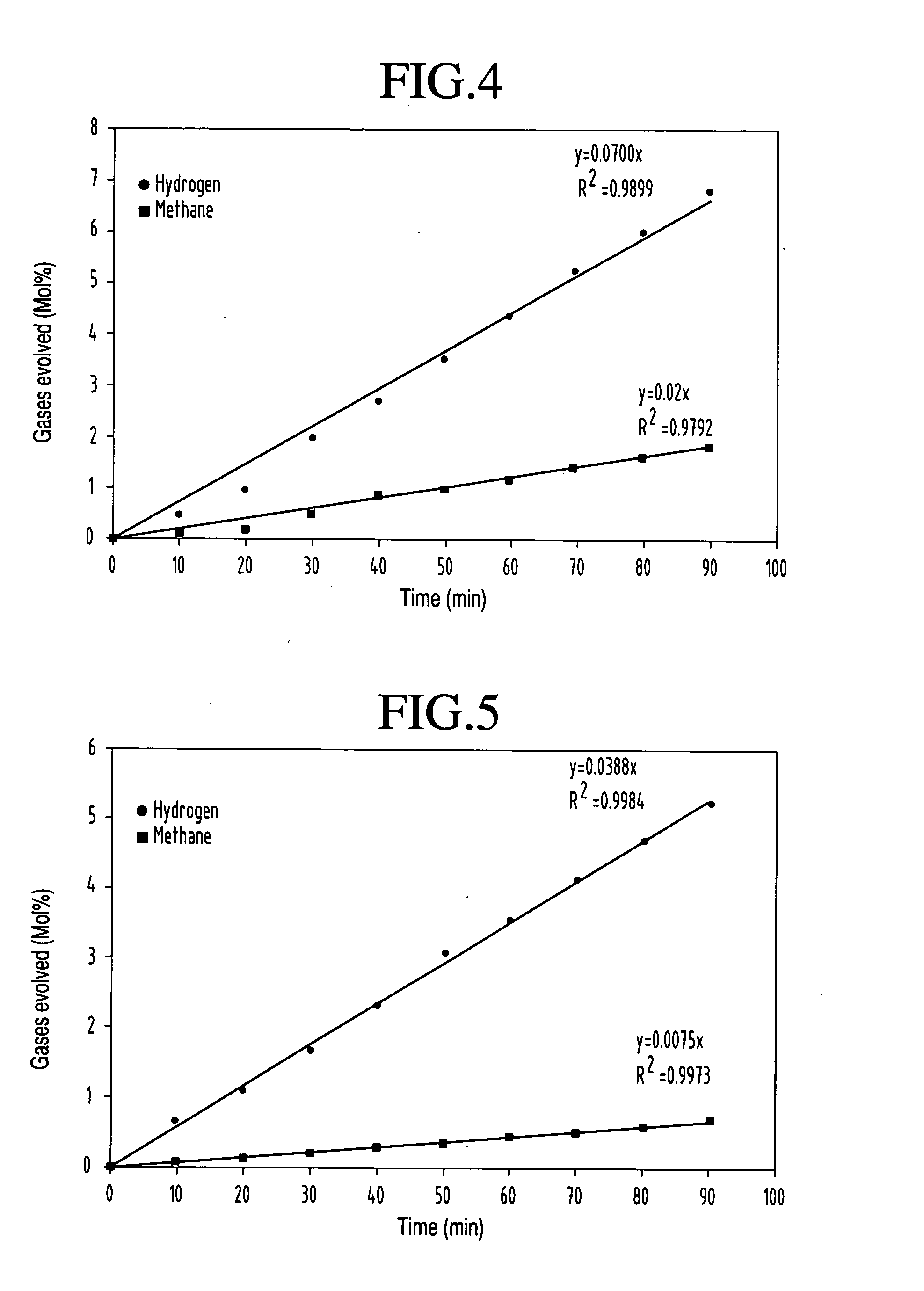Laser photo-catalytic process for the production of hydrogen
a photocatalytic process and laser technology, applied in chemical/physical/physical-chemical processes, metal/metal-oxide/metal-hydroxide catalysts, inorganic chemistry, etc., can solve the problems of low efficiencies of photovoltaic solar energy conversion, low initial cost, and slow reaction speed of photovoltaic energy conversion, etc., to achieve high hydrogen yield
- Summary
- Abstract
- Description
- Claims
- Application Information
AI Technical Summary
Benefits of technology
Problems solved by technology
Method used
Image
Examples
example 1
Effect of Laser Power on Hydrogen Production
[0040] This example illustrates the effect of incident laser power on hydrogen production for the photocatalytic conversion of methanol into hydrogen. In this experiment, methanol and a photocatalyst were mixed in the reaction cell. Specifically, 50 mL of methanol and 500 mg of WO3 catalyst were placed in the reaction cell. No evolution of gas was observed from the mixture of methanol and catalyst without laser irradiation. The absence of gas evolution indicates that the reformation of methanol does not occur and that hydrogen gas is produced only under illumination. The excitation source, a 355 nm wavelength high power laser beam was generated from the third harmonic of the Spectra Physics Nd:YAG laser (Model GCR 250). The laser energy per pulse was varied from 50 mJ to 300 mJ. The reaction products were characterized using a gas chromatographic system equipped with a wide bore capillary column and TCD detector. The products include hyd...
example 2
Effect of Catalyst Concentration on Hydrogen Yield
[0041] This example illustrates the relationship of hydrogen yield and catalyst concentration for photocatalytic conversion of methanol into hydrogen. In this experiment, methanol and WO3 photocatalyst were mixed in the reaction cell. The dependence of yield on catalyst concentration was studied by keeping all the other parameters such as laser energy and laser exposure time constant. In this case, hydrogen yield for various concentrations of WO3 catalyst were measured by using the same procedure mentioned above. Here the concentration of WO3 was varied from 50 mg to 2000 mg and the yield shows strong dependence on the concentration of catalyst from 50 to 500 mg. Here the laser energy was for higher concentrations the yield is not as dependent on catalyst concentration. No evolution of any product gas was observed from the mixture of methanol and catalyst without laser irradiation. The absence of gas evolution indicates that the ph...
example 3
Evolution of Hydrogen Production with Exposure Time Over Fe2O3 Catalyst
[0042] This example illustrates how the hydrogen production yield varies with time during the photocatalytic conversion of methanol into hydrogen using Fe2O3 as a catalyst. In this experiment, methanol and Fe2O3 photocatalyst were mixed in the reaction cell. The dependence of production yield on laser exposure was studied by keeping all the other parameters such as laser energy and Fe2O3 catalyst concentration as constant. In this case, hydrogen yield at regular time intervals using Fe2O3 catalyst was measured. Here the concentration of Fe2O3 was 500 mg while laser energy was 150 mJ per pulse. A typical plot of hydrogen yield (mole %) and methane (mole %) versus the laser exposure time is presented in FIG. 3. A maximum hydrogen yield of 4.3 mole % was achieved within 90 minutes which is quite substantial compared to other techniques at room temperature using a small volume of methanol.
[0043] The excitation sou...
PUM
| Property | Measurement | Unit |
|---|---|---|
| Temperature | aaaaa | aaaaa |
| Temperature | aaaaa | aaaaa |
| Temperature | aaaaa | aaaaa |
Abstract
Description
Claims
Application Information
 Login to View More
Login to View More - R&D
- Intellectual Property
- Life Sciences
- Materials
- Tech Scout
- Unparalleled Data Quality
- Higher Quality Content
- 60% Fewer Hallucinations
Browse by: Latest US Patents, China's latest patents, Technical Efficacy Thesaurus, Application Domain, Technology Topic, Popular Technical Reports.
© 2025 PatSnap. All rights reserved.Legal|Privacy policy|Modern Slavery Act Transparency Statement|Sitemap|About US| Contact US: help@patsnap.com



